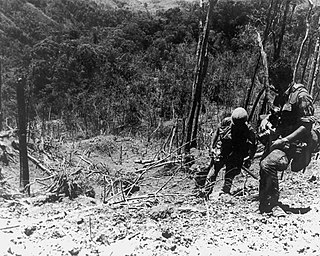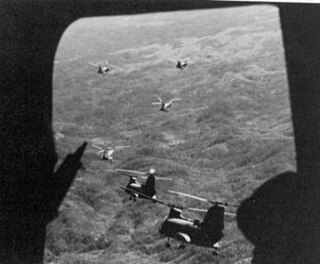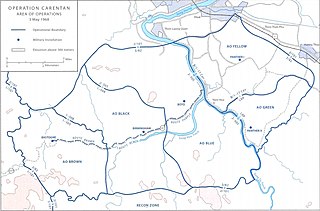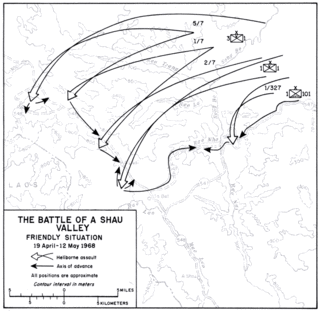
The 1st Cavalry Division is a combined arms division and is one of the most decorated combat divisions of the United States Army. It is based at Fort Cavazos, Texas. It was formed in 1921 and served during World War II, the Korean War, the Vietnam War, the Persian Gulf War, with the Stabilization Force in Bosnia-Herzegovina, in the Iraq War, in the War in Afghanistan as well as Operation Freedom's Sentinel and Operation Inherent Resolve. As of July 2023, the 1st Cavalry Division is subordinate to III Armored Corps and is commanded by Major General Thomas M. Feltey

The Battle of Khe Sanh was conducted in the Khe Sanh area of northwestern Quảng Trị Province, Republic of Vietnam, during the Vietnam War. The main US forces defending Khe Sanh Combat Base (KSCB) were two regiments of the United States Marine Corps supported by elements from the United States Army and the United States Air Force (USAF), as well as a small number of Army of the Republic of Vietnam (ARVN) troops. These were pitted against two to three divisional-size elements of the North Vietnamese People's Army of Vietnam (PAVN).

The battle of Dak To in Vietnam was a series of major engagements of the Vietnam War that took place between 3 and 23 November 1967, in Kon Tum Province, in the Central Highlands of the Republic of Vietnam. The action at Đắk Tô was one of a series of People's Army of Vietnam (PAVN) offensive initiatives that began during the second half of the year. PAVN attacks at Lộc Ninh, Sông Bé and at Con Thien and Khe Sanh,, were other actions which, combined with Đắk Tô, became known as "the border battles". The post hoc purported objective of the PAVN forces was to distract American and South Vietnamese forces away from cities towards the borders in preparation for the Tet Offensive.

A long-range reconnaissance patrol, or LRRP, is a small, well-armed reconnaissance team that patrols deep in enemy-held territory.

The Battle of Hamburger Hill was fought by US Army and Army of the Republic of Vietnam (ARVN) forces against People's Army of Vietnam (PAVN) forces during Operation Apache Snow of the Vietnam War. Though the heavily-fortified Hill 937, a ridge of the mountain Dong Ap Bia in central Vietnam near its western border with Laos, had little strategic value, US command ordered its capture by a frontal assault, only to abandon it soon thereafter. The action caused a controversy among both the US armed services and the public back home, and marked a turning point in the U.S. involvement.

The A Shau Valley is a valley in Vietnam's Thừa Thiên-Huế Province, west of the coastal city of Huế, along the border of Laos. The valley runs north and south for 40 kilometers and is a 1.5-kilometer-wide flat bottomland covered with tall elephant grass, flanked by two densely forested mountain ridges whose summits vary in elevation from 900 to 1,800 meters. A Shau Valley was one of the key entry points into South Vietnam for men and material brought along the Ho Chi Minh trail by the North Vietnamese Army and was the scene of heavy fighting during the Vietnam War. The A Shau Valley is bisected lengthwise by Route 548. The Ho Chi Minh Highway now runs along the valley floor.

Operation Dewey Canyon was the last major offensive by the 3rd Marine Division during the Vietnam War. It took place from 22 January through 18 March 1969 and involved a sweep of the People's Army of Vietnam (PAVN)–dominated A Shau and Song Đa Krông Valleys by the 9th Marine Regiment. Based on intelligence and captured documents, the PAVN unit in contact was believed to be the 9th Regiment.
The Battle of A Shau was waged in early 1966 during the Vietnam War between the People's Army of Vietnam (PAVN) and the forces of the United States and South Vietnam. The battle began on March 9 and lasted until March 10 with the fall of the U.S. Army's Special Forces camp of the same name. The battle was a strategic victory for the PAVN in that they were able to take control of the A Shau Valley and use it as a base area for the rest of the war.

Operation Wheeler/Wallowa was a U.S. offensive operation during the Vietnam War, launched on 11 September 1967 as two separate operations and concluding in November 1968. Initially named as Operation Wheeler and Wallowa, this was merged in November 1967 as Wheeler/Wallowa. The operation was at first conducted by the 101st Airborne Division and 1st Cavalry Division, but it was progressively taken over by 23rd Infantry (Americal) Division.

Operation Carentan and Operation Carentan II were security operations conducted during the Vietnam War by the U.S. 1st and 2nd Brigades, 101st Airborne Division and the 3rd Brigade, 82nd Airborne Division in Thừa Thiên Province, South Vietnam from 18 March to 17 May 1968.
A long-range penetration patrol, group, or force is a special operations unit capable of operating long distances behind enemy lines far away from direct contact with friendly forces as opposed to a Long Range Reconnaissance Patrol, a small group primarily engaged in scouting missions.
A Lưới is a rural district of Thừa Thiên Huế province in the North Central Coast region of Vietnam. It is located west in the highly mountainous area of A Shau Valley bordering Laos. The population includes many Bru, Hoa and Tà Ôi people. As of 2003 the district had a population of 38,616. The district covers an area of 1,229 km2 and its capital lies at A Lưới, a former French airfield, later used by the Americans in Operation Delaware and then by the North Vietnamese for courier flights.
Recondo is an American military acronym for a highly specialized infantry training or a graduate of a Recondo School who leads a small, heavily armed long-range reconnaissance team that patrols deep in enemy-held territory. It is also the colloquial name for a Marine who has graduated the grueling Basic Reconnaissance Course and earned the title of Recon Marine.

Operation Delaware/Operation Lam Son 216 was a joint military operation launched during the Vietnam War. It began on 19 April 1968, with troops from the United States and the Army of the Republic of Vietnam (ARVN) moving into the A Sầu Valley. The A Sầu Valley was a vital corridor for moving military supplies coming from the Ho Chi Minh Trail and was used by the People's Army of Vietnam (PAVN) as a staging area for numerous attacks in northern I Corps. Other than small, special operations reconnaissance patrols, American and South Vietnamese forces had not been present in the region since the Battle of A Shau in March 1966, when a U.S. Special Forces camp located there was overrun.
The Battle of Signal Hill was a company size engagement between members of Company E, 52nd Infantry (LRP) long-range reconnaissance patrol of the 1st Cavalry Division (Airmobile) and the People's Army of Vietnam (PAVN) from 19 to 21 April 1968 during Operation Delaware. Signal Hill was the name given to the peak of Dong Re Lao Mountain, a densely forested 4,878-foot (1,487 m) mountain in the A Sầu Valley. The strategic location made it an ideal communication and fire support site, vital to the success of Operation Delaware.
Company E, 52nd Infantry, (LRP) was a 120 man-sized long-range reconnaissance patrol unit attached to the 1st Cavalry Division (Airmobile) in Vietnam in 1967-69. Its origin begins on January 1, 1967, as "LRRP Detachment G2," 1st Cavalry Division (Airmobile). It was then redesignated "Headquarters & Headquarters Company LRRP Detachment" in April 1967, and redesignated "Company E, 52nd Infantry (LRP)" on December 20, 1967.

Operation Sam Houston was a US Army operation that took place in the Plei Trap Valley and around Plei Doc, lasting from 12 February to 5 April 1967.
Operation Neosho was a security operation in northern Thừa Thiên Province, South Vietnam from 1 November 1967 to 25 January 1968.

Operation Wayne Grey was an operation carried out by the United States Army, 1st Brigade, 4th Infantry Division and supporting elements, on March 1 to April 14, 1969. Its main objective was to cut off lines of communication and supply to the People's Army of Vietnam (PAVN) 24th and 66th Infantry Regiments as well as preventing them from retreating into Cambodia.

Operation Crockett was an operation during the Vietnam War conducted by the United States Marine Corps against People's Army of Vietnam (PAVN) forces around Khe Sanh Combat Base in northwest Quảng Trị Province that took place from 13 May to 16 July 1967. The PAVN tested U.S. defenses, forcing the Marines to deploy additional forces to the area, following which the PAVN disengaged but did not withdraw from the area. The operation resulted in 111 PAVN killed and one captured for Marine losses of 34 killed. The operation was immediately followed by Operation Ardmore, an ongoing security operation.













